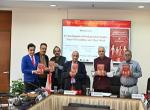Background
Rohingyas, with a population of nearly 1.1 million, are mostly Muslims living largely in Myanmar’s western coastal state of Rakhine and also in Bangladesh, Thailand and Malaysia. There are about 40,000 of them also living as illegal migrants in India. According to a World Bank report, 78 percent of the Rohingyas are living in a state of abject poverty and are considered as the ‘most oppressed ethnic community in the world’.
The majority Buddhist community in Myanmar consider them as illegal migrants. Myanmar government claims that these people are not its citizens and they pose grave threat to the country’s security through their illegal activities. Over the year in Myanmar, Rohingyas have been frequently subjected to military repression. Around 2, 00,000 and have illegally settled down across the borders in Bangladesh, till the recent wave of large scale migration.

The Crisis
Following a series of coordinated attacks on the Myanmar military establishments in August 2017 leading to the death of nine Myanmar Army (MA) officers and over 400 civilians, allegedly carried out by members of the Arakan Rohingya Solidarity Organisation (ARSO), the MA launched a major crackdown and cleaning up operation in which 79 ARSO activists were killed and Rohingyas in large numbers started fleeing out of the area into Bangladesh. According to Bangladesh authorities, over 65, 00,000 refugees fled into its bordering areas, taking the total number of illegal migrants and refugees to over 85 lakh.
These unprecedented developments have not only led to huge strains on Bangladesh’s over stretched resources but also posed acute humanitarian, social and security challenges. These also have potentially negative implications for the bordering states of India’s North East.
Discussion and Inferences
To discuss the implications of the crisis, a brainstorming session of experts was organised by the Vivekananda International foundation (VIF) on October 30, 2017. Discussants included Dr. Arvind Gupta, Director, Mr. C D Sahay, Lt Gen Ravi Sawhney, former Ambassadors Satish Chandra, Gautam Mokhopadhya, and Dinkar Srivastava, Dr. V S Seshadri, Bhaskar Mitra, Mr. Jayant Roychoudhury Mr. Shantanu Mukherjee and others.

Panelists agreed that the developments carried a combination of humanitarian tragedy, illegal immigration, economic deprivation, Human Rights concerns, identity issues, religious overtones and security implications. It was also agreed that responsibilities for early and workable resolution lay primarily with Myanmar and Bangladesh with roles cut out for India and the Islamic world, and with essential involvement of the UN bodies in providing for relief and rehabilitation. Participants expressed the apprehension that given the past experience of the Myanmar Government, any large scale return of refugees was unlikely to happen.
On security related issues, there was near unanimity that activities of organizations like the Arakan Rohingya Salvation Army, Arakan Rohingya National Solidarity Organisation (ARSO) etc. in concert with extremist Pakistan based and Al Qaeda aligned Islamist groups, would have serious implications for Bangladesh, India and the South and South East Asian countries. Better coordinated intelligence and security approach would be required to effectively deal with the existing and emerging threats.
Recommendations also included for India to develop an effective refugee policy, and support to Bangladesh in mitigating the humanitarian impact of the refugee crisis. India could also, without attempting to play the role of a mediator, encourage both the countries through quiet diplomacy to arrive at a reasonable solution. Through their international partners, the possibility of ‘organised migration to third countries’ could also be an option to explore.




